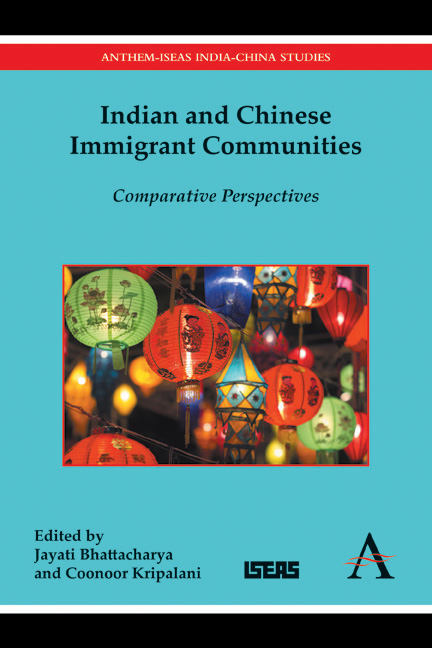Book contents
- Frontmatter
- Contents
- Foreword
- Acknowledgements
- Introduction
- Section I Historical Antecedents and the Question of Nationality
- Section II The Meeting Ground: Indians and Chinese in Southeast Asia
- 4 China's Nationality Laws and the Chinese Overseas
- 5 A Comparison of the Home Remittance Systems of Indian and Chinese Migrants in Southeast Asia: Nineteenth and Twentieth Centuries
- 6 Identity, Transnationalism and Corporate Development: Chinese Business in Malaysia
- 7 Beyond the Glitterati: The Indian and Chinese Jewellers of Little India, Singapore
- 8 Indian and Chinese Communities in Contemporary Burma: A Comparative Analysis of Their Presence and Influence
- 9 Expressions of Faith in Hindu Processional Festivals: Case Studies from Singapore and Malaysia
- 10 Beyond Boundaries? Hindu Spaces in the Chinatowns of Kolkata and Singapore
- Section III Indians in China and Chinese in India
- Section IV Across the Globe: Indian and Chinese Diasporas
- Postscript Shifting Worlds and Changing Identities: The Reshaping of the Chinese-Indian Communities in India after the 1962 “Sino-Indian Incident”
- List of Contributors
- Index
5 - A Comparison of the Home Remittance Systems of Indian and Chinese Migrants in Southeast Asia: Nineteenth and Twentieth Centuries
from Section II - The Meeting Ground: Indians and Chinese in Southeast Asia
Published online by Cambridge University Press: 05 December 2015
- Frontmatter
- Contents
- Foreword
- Acknowledgements
- Introduction
- Section I Historical Antecedents and the Question of Nationality
- Section II The Meeting Ground: Indians and Chinese in Southeast Asia
- 4 China's Nationality Laws and the Chinese Overseas
- 5 A Comparison of the Home Remittance Systems of Indian and Chinese Migrants in Southeast Asia: Nineteenth and Twentieth Centuries
- 6 Identity, Transnationalism and Corporate Development: Chinese Business in Malaysia
- 7 Beyond the Glitterati: The Indian and Chinese Jewellers of Little India, Singapore
- 8 Indian and Chinese Communities in Contemporary Burma: A Comparative Analysis of Their Presence and Influence
- 9 Expressions of Faith in Hindu Processional Festivals: Case Studies from Singapore and Malaysia
- 10 Beyond Boundaries? Hindu Spaces in the Chinatowns of Kolkata and Singapore
- Section III Indians in China and Chinese in India
- Section IV Across the Globe: Indian and Chinese Diasporas
- Postscript Shifting Worlds and Changing Identities: The Reshaping of the Chinese-Indian Communities in India after the 1962 “Sino-Indian Incident”
- List of Contributors
- Index
Summary
Introduction: Migration and Remittance
There were many differences in the history and dynamics of emigration between South Asia, Southeast Asia and South China over the nineteenth and twentieth centuries. These differences had, in turn, a far-reaching impact on patterns of remittance transmission back to home villages of origin. While these remittances were earmarked by their senders as household expenses and investment capital, the present study reveals that the financial instruments in which these funds were actually used were conditioned by a wide range of locally specific environmental, infrastructural and politico-economic factors. To understand migration and its relationship with remittances, we need to consider thoroughly the environmental, infrastructural and politico-economic circumstances affecting migrants and their families. This chapter, however, will discuss the similarity in the procedures of home remittances between Indians and Chinese in Southeast Asia. As their business networks utilized informal financial markets, they quite commonly used their local, business and family ties for remittances. The relations between overseas and home towns, at the same time, were strengthened by exchanging money, achieving credit for each other.
Politically and economically speaking, Hong Kong and Singapore have a strong connection as former British colonies. In 1858, the British East India Company, its trade monopoly gone, lost control over the Straits Settlements of Penang, Singapore and Malacca, established as a crown colony in 1867. In the late nineteenth century rubber plantations and tin mines attracted many Indian and Chinese labourers to the Malay Peninsula. During this period, Singapore and Hong Kong became transit points for immigrants and their home remittances, as well as entrepôts for Western capital and settlement points for financial transactions.
Hong Kong and Chinese Migration
Abolition of the slave trade in the 1830s exacerbated a labour shortage in the British Empire and led to the recruitment of Indians and Chinese to work on the sugar plantations of the West Indies and the new rubber and sugar plantations of Southeast Asia.
- Type
- Chapter
- Information
- Indian and Chinese Immigrant CommunitiesComparative Perspectives, pp. 55 - 76Publisher: Anthem PressPrint publication year: 2015

